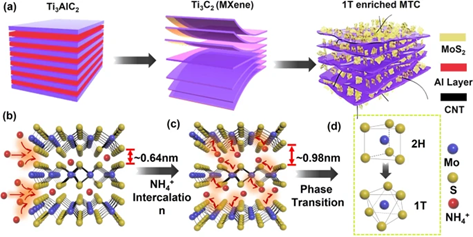High-Performance Anode Materials for Lithium-Ion Batteries Using MoS2/MXene/CNT
A MoS2/MXene/CNT anode for high-capacity Li-ion batteries with improved low temperature operation.
Extremely high energy density batteries are needed for underwater electric ships such as unmanned submarines and naval observatories. Rechargeable lithium-ion batteries (LIBs) are the most widely used battery system in portable electronics and electric vehicles nowadays because of their high energy per unit mass, power-to-weight ratio, high temperature performance, and low self-discharge. Nevertheless, conventional graphite anode exhibits a rather small theoretical maximum Li storage capacity (372 mAh g-1) which is far from the satisfaction for the development of modern society.
As an inexpensive and naturally abundant 2D material, molybdenum disulfide (MoS2), a representative TMD material, provides a highly competitive landscape in terms of electrochemical performance when employed as a LIB anode. A ternary nanocomposite consisting of dual-phase MoS2, highly conductive Ti3C2 MXene and one-dimensional (1D) carbon nanotubes (CNTs) via a one-step solvothermal method in a bisolvent media was constructed. The metallic phase content was found to be 66%. The highly conductive MXene served as an ideal backbone for MoS2 nucleation and the formed hierarchical sandwiched structure prevented the undesired oxidation and restacking of 2D layers. 2D islands of dual-phase MoS2 and Ti3C2 MXene were bridged by the 1D CNTs which synergistically boosted the overall network conductivity.

- Manufacturing process is easy and costs less.
- A higher capacity (1,290 mAh g-1) is achieved than conventional graphite anode (372 mAh g-1).
- Booster network conductivity leads to faster charging times.
In cold areas, electric vehicles with lithium metal anode have a slow charge rate performance. This battery creates a fast charge in 20 minutes.
U.S. Provisional Patent Application 63/457,093 filed April 4, 2023
TRL 5
Available for licensing or collaboration.
Patent Information:
| App Type |
Country |
Serial No. |
Patent No. |
Patent Status |
File Date |
Issued Date |
Expire Date |
|